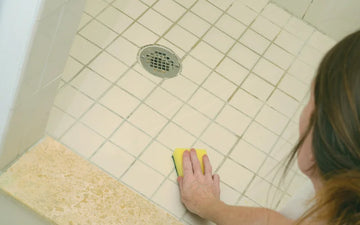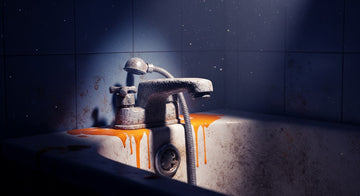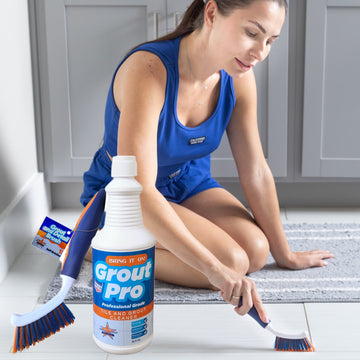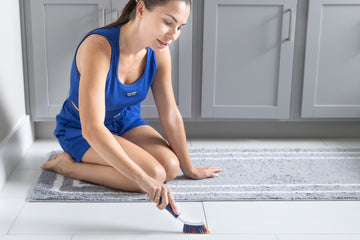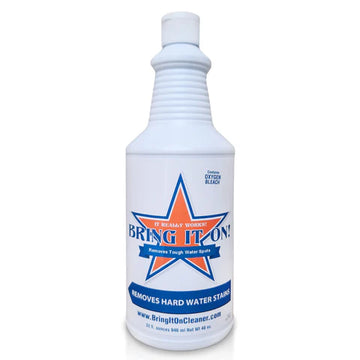Removing Soap Scum
Soap scum is that stubborn, filmy layer that forms on showers and tubs and sinks over time. Not only is it unsightly, but it can also be tough to remove, especially if left untreated for long. Fortunately, you can say goodbye to this unwelcome bathroom and kitchen guest with the right techniques and products. Here's a comprehensive guide to remove soap scum from various surfaces.
Understanding Soap Scum

Before diving into the removal process, it's essential to understand what you're dealing with.
What is Soap Scum?
Soap scum results from the mixture of minerals in water, especially magnesium, with fatty acids from bar soap. When the minerals bond with these acids, it forms a residue on surfaces, particularly on bathroom surfaces like shower walls, glass doors, and tubs.
Read more about: How to Clean Glass Shower Doors - A Step-by-Step Guide.
Why is it a Problem?
Beyond being a visual nuisance, soap scum can harbor bacteria, leading to mold and mildew, especially in the damp bathroom environment. It can make surfaces slippery, posing a risk in showers and bathtubs.
Necessary Supplies for Removing Soap Scum
Gather these household products and tools to effectively tackle the soap scum in your bathroom or kitchen.
Products You'll Need
- White vinegar
- Baking soda
- Dish soap or dish detergent
- Hydrogen peroxide (optional for stubborn mold and mildew)
Tools Required
- Spray bottle
- Bowl or cup
- Drill Brush
- Sponge or microfiber cloth
- Old toothbrush or brush
- Squeegee or towel
DIY Techniques to Remove Soap Scum

Here are some tried-and-true ways to get rid of soap scum using ingredients commonly found in homes.
Vinegar and Dish Soap Mixture
- In a spray bottle, combine equal amounts of white vinegar and dish soap. Shake well.
- Spray the solution generously on the affected area.
- Let it sit for 15 minutes.
- Use a sponge or microfiber cloth to scrub the area.
- Rinse with water and dry with a towel or squeegee.
Baking Soda Scrub
- In a bowl, mix enough water with baking soda to form a paste.
- Apply the paste to the soap scum.
- Work it in with some elbow grease, using a brush for tougher stains.
- Rinse off with water.
For Stubborn Stains, Hydrogen Peroxide
If you notice mold and mildew forming alongside soap scum, hydrogen peroxide can be your best bet.
- Apply a small amount of hydrogen peroxide to the stain.
- Let it sit for 10 minutes.
- Scrub and rinse.
Prevention Tips
Prevention is better than cure. Here's how to keep soap scum at bay.
- Switch to Shower Gel
- Regular Cleaning
- Install a Water Softener
Switch to Shower Gel
One of the simplest ways is switching from bar soap to shower gel, as it tends to leave less residue.
Regular Cleaning
Wipe down surfaces with a squeegee or microfiber cloth after each shower. This reduces the buildup of minerals and soap on surfaces.
Install a Water Softener
If you have hard water, consider investing in a water softener. It reduces the amount of magnesium and other minerals in water, thus lessening soap scum formation.
Get yourself "Hardwater Stain Remover"
Conclusion
Removing soap scum can be challenging, but with the right techniques, products, and patience, you can have sparkling clean surfaces in no time. Regular cleaning and some preventive measures can ensure that you spend less time scrubbing and more time enjoying your bathroom and kitchen spaces.
I have found the best product to remove soap scum from surfaces, here is my recommendation. Bring It On Cleaner
Frequently Asked Questions
How long does it take for soap scum to form?
It varies, but with regular use, noticeable soap scum can form in as little as a week.
Does hard water increase soap scum buildup?
Yes, hard water contains more minerals, which can lead to quicker and thicker soap scum formation.
Can I use bleach to get rid of soap scum?
While bleach can disinfect and remove stains, it's not the most effective at breaking down soap scum. It's better for mold and mildew.

